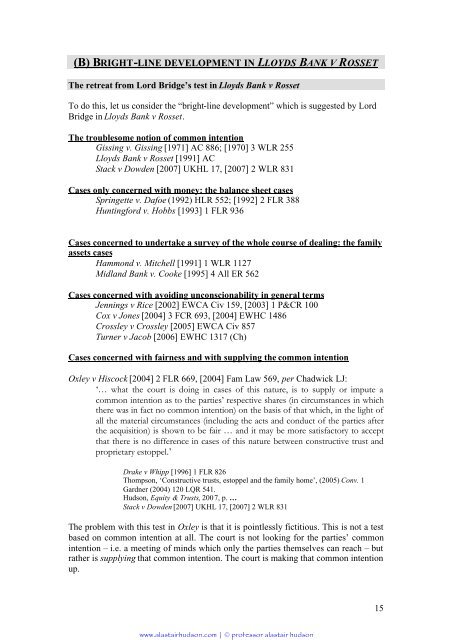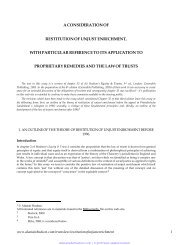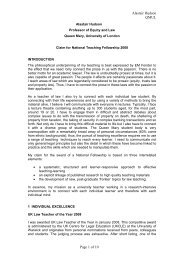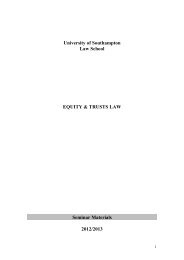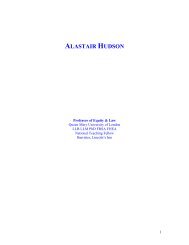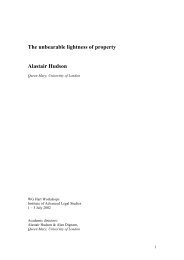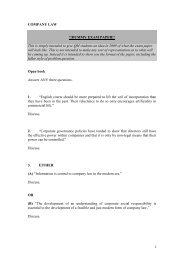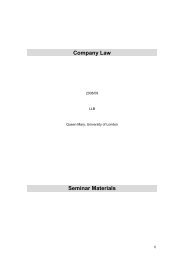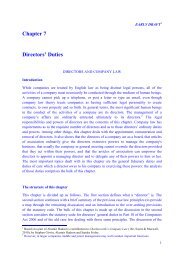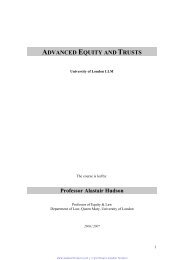England's dreaming equity, trust and conscience - alastairhudson.com
England's dreaming equity, trust and conscience - alastairhudson.com
England's dreaming equity, trust and conscience - alastairhudson.com
You also want an ePaper? Increase the reach of your titles
YUMPU automatically turns print PDFs into web optimized ePapers that Google loves.
(B) BRIGHT-LINE DEVELOPMENT IN LLOYDS BANK V ROSSETThe retreat from Lord Bridge’s test in Lloyds Bank v RossetTo do this, let us consider the “bright-line development” which is suggested by LordBridge in Lloyds Bank v Rosset.The troublesome notion of <strong>com</strong>mon intentionGissing v. Gissing [1971] AC 886; [1970] 3 WLR 255Lloyds Bank v Rosset [1991] ACStack v Dowden [2007] UKHL 17, [2007] 2 WLR 831Cases only concerned with money: the balance sheet casesSpringette v. Dafoe (1992) HLR 552; [1992] 2 FLR 388Huntingford v. Hobbs [1993] 1 FLR 936Cases concerned to undertake a survey of the whole course of dealing: the familyassets casesHammond v. Mitchell [1991] 1 WLR 1127Midl<strong>and</strong> Bank v. Cooke [1995] 4 All ER 562Cases concerned with avoiding unconscionability in general termsJennings v Rice [2002] EWCA Civ 159, [2003] 1 P&CR 100Cox v Jones [2004] 3 FCR 693, [2004] EWHC 1486Crossley v Crossley [2005] EWCA Civ 857Turner v Jacob [2006] EWHC 1317 (Ch)Cases concerned with fairness <strong>and</strong> with supplying the <strong>com</strong>mon intentionOxley v Hiscock [2004] 2 FLR 669, [2004] Fam Law 569, per Chadwick LJ:‘… what the court is doing in cases of this nature, is to supply or impute a<strong>com</strong>mon intention as to the parties’ respective shares (in circumstances in whichthere was in fact no <strong>com</strong>mon intention) on the basis of that which, in the light ofall the material circumstances (including the acts <strong>and</strong> conduct of the parties afterthe acquisition) is shown to be fair … <strong>and</strong> it may be more satisfactory to acceptthat there is no difference in cases of this nature between constructive <strong>trust</strong> <strong>and</strong>proprietary estoppel.’Drake v Whipp [1996] 1 FLR 826Thompson, ‘Constructive <strong>trust</strong>s, estoppel <strong>and</strong> the family home’, (2005) Conv. 1Gardner (2004) 120 LQR 541.Hudson, Equity & Trusts, 2007, p. …Stack v Dowden [2007] UKHL 17, [2007] 2 WLR 831The problem with this test in Oxley is that it is pointlessly fictitious. This is not a testbased on <strong>com</strong>mon intention at all. The court is not looking for the parties’ <strong>com</strong>monintention – i.e. a meeting of minds which only the parties themselves can reach – butrather is supplying that <strong>com</strong>mon intention. The court is making that <strong>com</strong>mon intentionup.15www.<strong>alastairhudson</strong>.<strong>com</strong> | © professor alastair hudson


